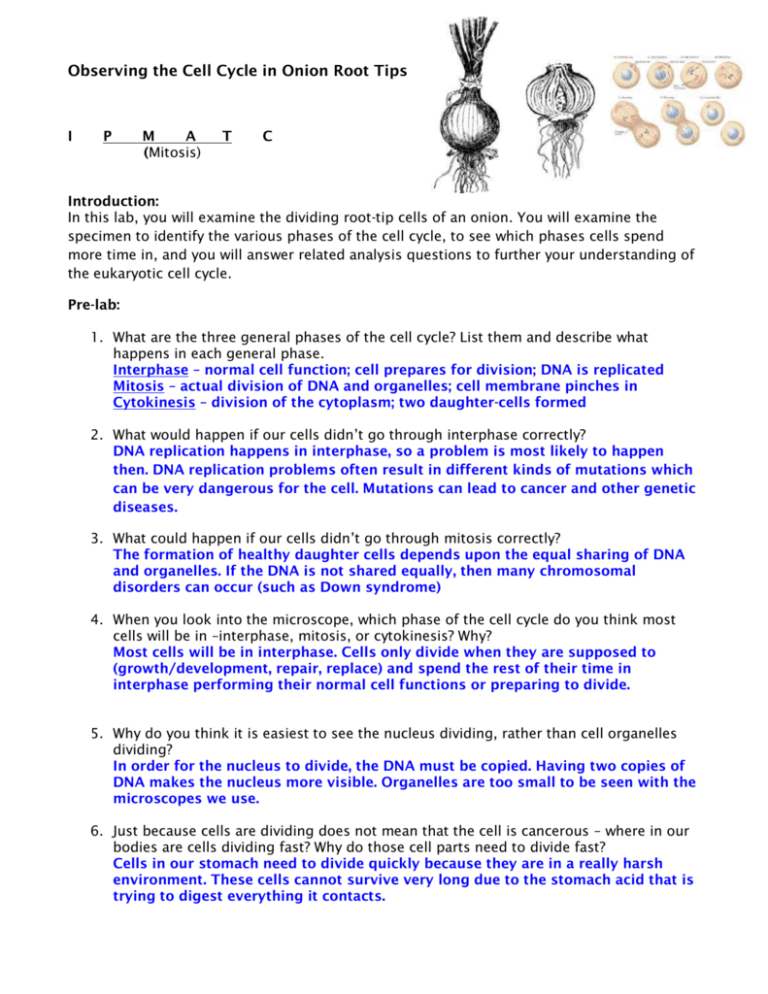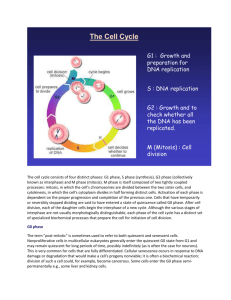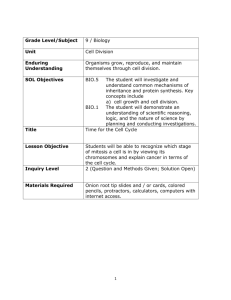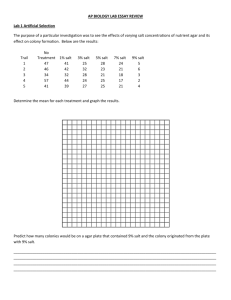Observing the Cell Cycle in Onion Root Tips I P M A T C (Mitosis
advertisement

Observing the Cell Cycle in Onion Root Tips I P M A (Mitosis) T C Introduction: In this lab, you will examine the dividing root-tip cells of an onion. You will examine the specimen to identify the various phases of the cell cycle, to see which phases cells spend more time in, and you will answer related analysis questions to further your understanding of the eukaryotic cell cycle. Pre-lab: 1. What are the three general phases of the cell cycle? List them and describe what happens in each general phase. Interphase – normal cell function; cell prepares for division; DNA is replicated Mitosis – actual division of DNA and organelles; cell membrane pinches in Cytokinesis – division of the cytoplasm; two daughter-cells formed 2. What would happen if our cells didn’t go through interphase correctly? DNA replication happens in interphase, so a problem is most likely to happen then. DNA replication problems often result in different kinds of mutations which can be very dangerous for the cell. Mutations can lead to cancer and other genetic diseases. 3. What could happen if our cells didn’t go through mitosis correctly? The formation of healthy daughter cells depends upon the equal sharing of DNA and organelles. If the DNA is not shared equally, then many chromosomal disorders can occur (such as Down syndrome) 4. When you look into the microscope, which phase of the cell cycle do you think most cells will be in –interphase, mitosis, or cytokinesis? Why? Most cells will be in interphase. Cells only divide when they are supposed to (growth/development, repair, replace) and spend the rest of their time in interphase performing their normal cell functions or preparing to divide. 5. Why do you think it is easiest to see the nucleus dividing, rather than cell organelles dividing? In order for the nucleus to divide, the DNA must be copied. Having two copies of DNA makes the nucleus more visible. Organelles are too small to be seen with the microscopes we use. 6. Just because cells are dividing does not mean that the cell is cancerous – where in our bodies are cells dividing fast? Why do those cell parts need to divide fast? Cells in our stomach need to divide quickly because they are in a really harsh environment. These cells cannot survive very long due to the stomach acid that is trying to digest everything it contacts. Lab: Look at the onion root tip slides. Choose a sample of about 50 cells. Look for a group of cells that appear to have been actively dividing at the time that the slide was made. The cells will appear in rows, so it should be easy to keep track of them. The dark stained bodies are the nuclei. Stage Sketch Description of what’s happening in each stage Estimated number or % of cells in that stage Interphase Normal cell functions; cell prepares to divide; the DNA is replicated (copied) 62% Prophase Nuclear membrane disappears; DNA condenses and forms chromosomes; centrioles begin to separate and spindle fibers form 12% Metaphase Chromosomes line up in the middle; centrioles have moved to the poles; spindle fibers are fully formed 4% Anaphase Centrioles pull the chromosomes apart so each side receives one copy 6% Telophase Nuclear membrane forms around both sets of chromosome; spindle fibers disappear as the cell membrane pinches in 8% Cytokinesis Cytoplasm divides in half as the cell membrane finishes developing; two identical daughter cells are created 8% Post lab: 1. Why is the onion root a good specimen for studying mitosis? Root cells need to divide in order to grow deep to provide support and get nutrients. 2. The majority of the cells in your specimen were in which stage of the cell cycle? Most of our cells were in interphase. 3. Why does it make sense that most cells in your specimen were in that stage? Most cells do not constantly divide, and only do so when needed. Most cells are either doing their normal cell functions or preparing to divide. 4. Cancerous tissue is composed of cells undergoing uncontrolled, rapid cell division. How could you develop a procedure to identify cancerous tissue by counting the number of cells undergoing mitosis? Since most normal cells are in interphase, you would want to make a procedure that can count the number of cells in interphase and in mitosis. If more are in interphase, the cell is normal; if more are in mitosis, then the cells may be cancerous. Use this image to determine your percentages and to help answer the remaining questions on page 2 of your lab.











